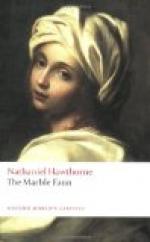From the old butler, whom he found to be a very gracious and affable personage, Kenyon soon learned many curious particulars about the family history and hereditary peculiarities of the Counts of Monte Beni. There was a pedigree, the later portion of which—that is to say, for a little more than a thousand years—a genealogist would have found delight in tracing out, link by link, and authenticating by records and documentary evidences. It would have been as difficult, however, to follow up the stream of Donatello’s ancestry to its dim source, as travellers have found it to reach the mysterious fountains of the Nile. And, far beyond the region of definite and demonstrable fact, a romancer might have strayed into a region of old poetry, where the rich soil, so long uncultivated and untrodden, had lapsed into nearly its primeval state of wilderness. Among those antique paths, now overgrown with tangled and riotous vegetation, the wanderer must needs follow his own guidance, and arrive nowhither at last.
The race of Monte Beni, beyond a doubt, was one of the oldest in Italy, where families appear to survive at least, if not to flourish, on their half-decayed roots, oftener than in England or France. It came down in a broad track from the Middle Ages; but, at epochs anterior to those, it was distinctly visible in the gloom of the period before chivalry put forth its flower; and further still, we are almost afraid to say, it was seen, though with a fainter and wavering course, in the early morn of Christendom, when the Roman Empire had hardly begun to show symptoms of decline. At that venerable distance, the heralds gave up the lineage in despair.
But where written record left the genealogy of Monte Beni, tradition took it up, and carried it without dread or shame beyond the Imperial ages into the times of the Roman republic; beyond those, again, into the epoch of kingly rule. Nor even so remotely among the mossy centuries did it pause, but strayed onward into that gray antiquity of which there is no token left, save its cavernous tombs, and a few bronzes, and some quaintly wrought ornaments of gold, and gems with mystic figures and inscriptions. There, or thereabouts, the line was supposed to have had its origin in the sylvan life of Etruria, while Italy was yet guiltless of Rome.
Of course, as we regret to say, the earlier and very much the larger portion of this respectable descent—and the same is true of many briefer pedigrees—must be looked upon as altogether mythical. Still, it threw a romantic interest around the unquestionable antiquity of the Monte Beni family, and over that tract of their own vines and fig-trees beneath the shade of which they had unquestionably dwelt for immemorial ages. And there they had laid the foundations of their tower, so long ago that one half of its height was said to be sunken under the surface and to hide subterranean chambers which once were cheerful with the olden sunshine.




